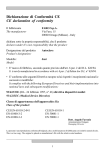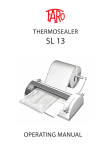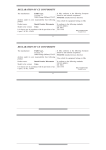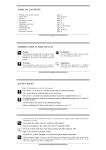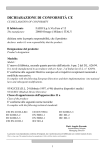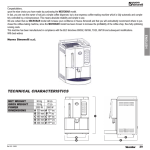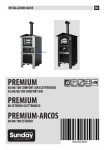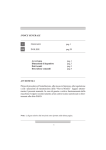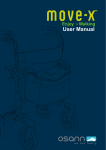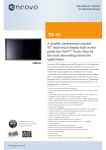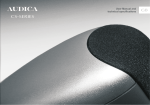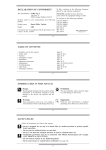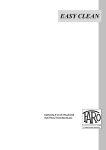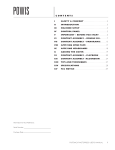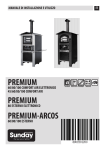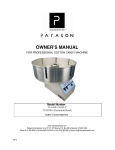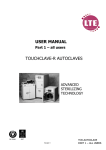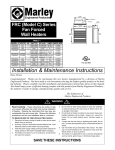Download Autoclave "TWIN"
Transcript
Autoclave "TWIN" MANUALE DI ISTRUZIONI INSTRUCTION MANUAL L'ODONTOTECNOLOGIA TABLE OF CONTENTS Symbols used in this manual Safety standards Features Description of parts Description of symbols Installation Operating instructions Maintenance Troubleshooting Technical Particulars Electrical diagram Piping diagram page page page page page page page page page page page page 22 23 24-25 26-27 28 29-30 31 32-33-34 35-36 37-38 39 40 41 SYMBOLS USED IN THIS MANUAL Danger The paragraphs marked with this symbol contain instructions which must be observed carefully to avoid damage to the device, the operator and the patient. Warnings These instructions advise that attention should be paid to avoid situations which could damage the device. Prohibition This icon shows what to avoid doing to avoid damage to the device. Suggestions This icon signals information permitting use of the device in the most effective manner. 23 SAFETY STANDARDS Observe all the instructions set forth in this manual. • The device is designed for use in a dental office by a doctor or his assistant under the doctor's responsability. • Equipment designed for sterilizing instruments, solid material and anything sterilizable in a temperature range from 121°C to 135°C. • The equipment is to be connected to the electric mains. • Do not perform any maintenance on the autoclave when power cord is plugged in. Disconnect the power cord from the mains before beginning repairs on the machine. • Do not set the "TWIN" autoclave on unsteady tables or shelves. • The "TWIN" autoclave electrical plug has a grounding wire. Make sure the outlet used has a ground connection. • To avoid useless and dangerous overheating of the "TWIN" auroclave, it is recommended to avoid encasing the machine in a piece of furniture but always ensure good natural ventilation. • The autoclave should be installed in a perfectly clean room. • Before using the device for the first time, clean the chamber as explained on page 35. • Make sure the input voltage is the same as that shown on the nameplate on the rear panel of the autoclave • Using an extension, make sure the type of cord used is capable of carrying the current absorbed by the equipment (16A) and that it is not crushed. • The tray should be withdrawn using the tool supplied. There is risk of burning if the autoclave is on standby at medium temperature with the resistance still on. • Falling of the autoclave could cause deformation of it and affect good operation. Our Service Departement should therefore inspect it completely after any fall. 24 • The "TWIN" autoclave operates with distilled water or Composite solution. Any other substance used would seriously prejudice operation of the equipment. If some other liquid is inadvertently added to the autoclave see our Service Departement for advice. • Only perform operations set forth in this manual. Any operation not described in this manual could prejudice the safety designed into the device. For any work not described in this manual apply to our Service Department. • When packed for transportation or storage this equipment should be capable of exposition for not over 15 weeks to environmental conditions outside the following ranges: ⇒ Surrounding temperature from -20°C to +70°C ⇒ Relative humidity from 10% to 90% ⇒ Atmospheric pressure from 500mBar to 1060 mBar. • The device conforms to harmonized standards for electromagnetic compatibility; it is not affected by nor does it cause electromagnetic disturbance. 25 FEATURES Device designed to sterilize with moist saturated steam or with "Composite" alcohol solution. This sterilizer is produced in the following model: "TWIN" Autoclave • The "TWIN" Autoclave served by a microcontroller is especially suited to the sterilization of metal and plastic articles. The "TWIN" Autoclave operates with either distilled water or alcohol solution (Composite). • "TWIN" has seven sterilization programs of which one is the program for performance of the last cycle (push-button 16). This provides automatic shutoff of the heating elements at the end of sterilization. • Machine ready is signaled by warning light 19. • An electric pump fills the liquid fill tank automatically (push-button 17). • Taps allow fast emptying of the drain and fill tanks for fast change of sterilization liquid. • Water inlet to the chamber by a metering device. • Steady pressure in the chamber during the sterilization cycle. • Automatic electronic control of the heating element, by safety system for overheating occuring during sterilization cycle. • Minimum level warning light 18. • Liquid fill push-button 17 and maximum level warning light. • Electronic locking of autoclave when minimum level warning light 18 goes on in fill tank. If it occurs during sterilization, the machine terminates the set cycle. To begin another cycle the fill tank must be filled with more liquid. • A non-resettable heat breaker which breaks only with electronic heatcontrol system failure is applied to the heating element. • Switch for selection of distilled water or alcohol solution (Composite). 26 • At cycle end, standby function starts at medium temperature to eliminate preheating and reduce sterilization time. Resistance with differentiated power to hold even temperature throughout the chamber. • Sound and light signal warns of cycle end. • The autoclave has an ABORT function and an ERROR function (notices appearing abbreviated on the display as Ab ABORT - Er ERROR). • ABORT (invalidation of cycle) indicates that sterilization did not take place. The notice appears on the display 60 minutes after water inlet to chamber. To restart the cycle, shut off and restart the autoclave using the main switch. • ERROR shows that the time elapsed after starting upon door closing is less than one minute, the time necessary for starting all the functions. Upon reopening the door the autoclave restarts automatically. • Reset push-button 11 held down the 3 seconds starts function. 27 DESCRIPTION OF PARTS fig. 1 1. 2. 3. 4. 5. 6. 7. 8. 9. Main switch Fuses Door close-open handle Drain tap (fill tank) Liquid selection switch (distilled water or Composite solution) Liquid fill connection Drain tap (drain tank) Control panel (see fig. 2, page 29) Pressure gauge 28 DESCRIPTION OF SYMBOLS fig. 2 10. 11. 12. 13. 14. 15. 16. 17. 18. 19. 20. Digital display RESET push-button Push-button to set 135°C distilled water cycle (metal - glass) Push-button to set 121°C distilled water cycle (plastic - rubber) FAST CYCLE push-button distilled water - COMPOSITE solution Push-button to set COMPOSITE SOLUTION CYCLE Push-button to set LAST CYCLE LIQUID FILL push-button / MAXIMUM LEVEL warning light MINIMUM LEVEL in fill tank warning light MACHINE READY warning light END OF CYCLE warning light 29 DESCRIPTION OF SYMBOLS fig. 3 1. 2. 3. 4. 5. 6. 7. 8. 9. 10. Porthole closed Porthole open Main switch on Main switch off Fill tank drain Fill tank fill Fuses Drain tank drain Composite switch Water switch 30 INSTALLATION Weight of "TWIN" autoclave is 50 kg (57 kg including packing). Grips are provided on the autoclave packing base. ⇒ ⇒ Remove packing from autoclave. Open door by turning handle 3 counterclockwise (fig. 1, page 28) and withdraw contents of chamber. Check to make sure the following items are received: ⇒ ⇒ ⇒ ⇒ ⇒ ⇒ ⇒ ⇒ Documentation (manual) Tray holder support (3 shelves) N. 3 trays N. 1 tray withdrawal pincer N. 1 door adjustment wrench N. 1 fill & drain tube N. 1 one-liter bottle of distilled water N. 1 one-liter bottle of Composite solution THE DEVICE MUST BE INSTALLED BY SPECIALIZED TECHNICHIANS. Set "TWIN" autoclave on a supporting surface and check levelness in both directions with level. Make sur the power outlet used is grounded. Plug in the autoclave cord making sure it is not crushed . 31 OPERATING INSTRUCTIONS To use the "TWIN" autoclave proceed as follows: • Press the luminous main switch 1 (fig. 1, page 28). The notice Pr appears on the display and the RESET warning light 11 lights up. • Open door by turning handle 3 counterclockwise (fig. 1, pag. 28). • Fill the filling tank with distilled water or Composite solution using the tube supplied. Insert the tube part with quick connector in the connector provided 6 (fig. 1, page 28) and the other end in the can. Press LIQUID FILL push-button 17 (fig. 2, page 29). When MAXIMUM LEVEL warning light 17 goes on the fill pump stops automatically • Select liquid with switch 5 (fig. 1, page 28). The "TWIN" autoclave will accept only the program for the selected liquid. • Clean the material to be sterilized, and then place it in the chamber well aligned on trays. • Set the cycle desired. The notice Ld will appear. • Wait 1 minute until the required sterilization time appears on the display. • Close the door by turning handle 3 clockwise (fig. 1, page 28). The programmed cycle is performed automatically. • Close drain tap during operation of sterilizer. 32 • Before setting desired cycle make sure the liquid in the fill tank is the liquid selected with switch 5 (fig. 1, page 28). In case of doubt it is advisable to empty the fill tank completely using the drain tap 4 (fig. 1, page 28) and fill it with the selected sterilization liquid. • Fill tank must be drained with door closed. PROGRAMS (symbols page 29 - fig. 2) ⇒ Push-button 12 135°C CYCLE duration 20 min. (cycle with water) ⇒ Push-button 14 FAST CYCLE at 135°C duration 15 min. (cycle with water) ⇒ Push-button 13 121°C CYCLE duration 32 min. (cycle with water) ⇒ Push-button 14 FAST CYCLE at 121°C duration 27 min. (cycle with water) ⇒ Push-button 15 COMPOSITE CYCLE duration 27 min. (cycle with Composite solution) ⇒ Push-button 14 FAST CYCLE with COMPOSITE duration 22 min. ⇒ Push-button 16 LAST CYCLE The "TWIN" autoclave will now carry out all functions of the set program through to the end of the cycle. • A 10-second acoustic signal and a warning light show end of cycle. With the LAST CYCLE programme, push-button 16, the acoustic signal is not heard. • At the end of complete sterilization cycle an END OF CYCLE warning light 20 is lit. The machine now goes on standby, lowering chamber temperature to avoid damage to instruments. • After performance of the LAST CYCLE, push-button 16, the resistance will go off automatically, leaving lit only the warning lights for end of cycle of the program set and the main switch. 33 • To reset the cycles after using LAST CYCLE, push-button 16, merely set the desired program cycle. • If the RESET push-button 11 has to be pressed, the cycle can be restarted with the push-button of the selected program. • In case of BLACK-OUT (power failure) the cycle is invalidated; proceed with a new program. Upon return of power the machine will be in RESET position. The program must be RESET with push-button 11 after replacing liquid. Pr will appear on the display. 34 MAINTENANCE Validation of sterilization cycle • Every two months make sure the sterilization cycle is validated using biological or chemical indicators available from the manufacturer or on the market. If the validation test is not satisfactory apply to our Service Department. Cleaning the sterilization chamber • If it becomes necessary to clean the sterilization chamber, turn off the main switch 1 (fig. 1, page 28) and allow chamber to cool. • To remove any residue left by liquid used, use products designed for dissolving limestone. To do this, use soft cloths so that the protective treatment of the chamber surface will not be damaged. • At the end of the operation rinse generously with water, then dry. • It is recommended to clean the chamber only in case of serious need so as to avoid damaging the protective coating. Cleaning front panel ⇒ Turn off main switch 1 (fig. 1, page 28). ⇒ To clean the front panel use a soft cloth slightly moistened in alcohol being careful to not penetrate therewith the inner parts of the autoclave. Instead of alcohol, any ammonia-based glass-cleaning product is tolerable. The use of detergents based on trichlorethylene, gasoline (petrol), turpentine or the like is strictly forbidden. 35 Adjusting door In case of poor door seal, adjust it using wrench "C" supplied. Proceed as follows. ⇒ Open door. ⇒ Insert wrench "C" in seat provided for this purpose in lower part of door. ⇒ Position wrench "C" on central nut "D". ⇒ Turn counterclockwise with regular angular movements from left to right, always completing the entire window opening travel. ⇒ Adjust door closing just enough to secure good seal (fig. 4). fig. 4 36 TROUBLESHOOTING The autoclave doesn't turn on, doesn't start or stops when running. • Make sure the plug is inserted in the power outlet and that the outlet operates correctly. • Check the condition of the fuses 2 (fig. 1, page 28) located on the front panel of the autoclave and replace them. • The heat safety breaker could have released because of excessive heat. This device is not resetting, so in case of problems call on our Service Department. • If the "minimum level" warning light 18 (fig. 2, page 29) is lit, fill the filling tank. • If none of the above conditions apply, call on our Service Department. The autoclave leaks water. • Empty the drain tank 7 (fig. 1, page 28), which must be emptied each time the unit is filled with liquid. • If the problem is not solved call on our Service Department. The autoclave doesn't get up pressure. • Clean door and gasket. • Adjust door closing (fig. 4, page 36). • Replace door gasket if necessary (this operation should be done only by an authorized technician). • For any other problems, call on our Service Department. 37 TROUBLESHOOTING Switch 5 is pressed inadvertently. • Before the door is closed the machine locks up and wait for instruction. • Reset switch 5 (fig. 1, page 28) to the position of the liquid in the tank. Reset and choose a program. • If the operation has to be done during the sterilization cycle, hence with door closed, the machine completes the cycle. In the following cycle the machine locks up automatically and waits for new instructions. 38 SPECIFICATIONS "TWIN" Input voltage : 230 V ac Mains frequency : 50 or 60 c.p.s. Power : 1725 W Input current, maximum : 7,5 A Noise level : < 60 dB (A) Electrical insulation class : I Operating temperature range : 0 ÷ 40°C Fuse : T8A Volume of chamber (dimensions dia x depth) : 15 dm3 (240 x 360 mm) Capacity of filling tank : 1300 cc Amount liquid used per cycle : 80 cc Operating pressure : Safety valve calibration pressure Dimensions : : 2,10 bar (at 135°C) 1,15 bar (at 121°C) 2,4 bar width444mm-H390mm-depth460+95mm Weight of autoclave : 50 kg 39 (57 kg with packing) TWIN AUTOCLAVE ELECTRICAL CONNECTION DIAGRAM FRONT PANEL PANEL CARD FILL TANK LEVEL SENSOR PRESSURE INLET 20-POLE FLAT CABLE POWER SUPPLY CARD 10-POLE FLAT CABLE BR = RESISTANCE FOR 230 V ac 1500 W BAND BT = BAND THERMOCOUPLE CM4 =NC CM5 =NC D2 = SWITCH, WATER OR COMPOSITE SELECTION DV = STEAM DISCHARGE EF = INTERFERENCE FILTER F1 = FUSE T 8 A F2 = FUSE T 8 A FR = FERRITE LP = FILL TANK PUMP 230 V ac MS = LUMINOUS NETWORK SWITCH MV= WATER METERING VALVE N.C. PM = DOOR MICROSWITCH PT = PRESSURE TRANSDUCER T = TRANSFORMER TS = HEAT SWITCH WV= CHAMBER FILL WATER 40 TWIN PIPING DIAGRAM PT SV PG DV HE WV MT MV DT C DF FT DF LP C = DF = DT = DV = FT = HE = LP = CHAMBER DRAIN TAP DRAIN TANK STEAM DISCHARGE FILL TANK HEAT EXCHANGER TANK FILL PUMP MT = MV = PG = PT = SV = WV= 41 METERING DEVICE METERING VALVE PRESSURE GAUGE PRESSURE TRANSDUCER SAFETY VALVE CHAMBER FILL WATER I CERTIFICATO DI GARANZIA La FARO concede al cliente finale una garanzia di 12 mesi, a partire dalla data della fattura di acquisto. La riparazione in garanzia dovrà essere effettuata presso la FARO o presso un Riparatore autorizzato FARO; spese e rischi di trasporto sono a carico dell'acquirente. Il certificato di garanzia che si trova sul risguardo del presente libretto è ritenuto valido soltanto se sarà compilato in tutte le sue parti e recherà il timbro del rivenditore. Il certificato consentirà la riparazione in garanzia (durante il periodo di validità) soltanto se accompagnerà l'articolo da riparare insieme alla bolla o fattura di vendita. La garanzia risponde dei guasti dovuti alla cattiva qualità del materiale o a difetti di fabbricazione; in caso di reclamo fondato la garanzia consentirà la riparazione o la sostituzione gratuita. E' esclusa la possibilità di ottenere risarcimento di danni e/o di interessi. La garanzia non è ritenuta valida, a insindacabile giudizio della FARO, in caso di manomissione, danneggiamento, di scorretta utilizzazione, di cattiva manutenzione o di normale usura. La garanzia non copre le lampadine e i fusibili. GB GUARANTEE CERTIFICATE FARO grants to the final customer a 12-months guarantee starting from the date of the purchase invoice. Repairs under the guarantee shall be done at the FARO premises or by an authorized FARO Service person with transportation costs and risks at the expense ofthe purchaser. The guarantee certificate found on the endleaf of this booklet is considered valid only ifit is entirely completed and bears the reseller’s stamp. Repairs under guarantee (during the period ofeffectiveness) wil be done only if it is accompanied by the shipping note or purchase invoice. The guarantee covers failures due to poor material quality or manufacturing defects and in case of legitimate claim the guarantee will allow repair or replacement free of charge. No compensation for damages and/or interest will be recognized. The guarantee is not deemed valid in the final judgment of FARO in case of tampering, damage, incorrect use, faulty maintenance or normal wear. The guarantee does not cover lamps and fuses. Autoclave "TWIN" CERTIFICATO DI GARANZIA GUARANTEE CERTIFICATE L'ODONTOTECNOLOGIA nome - name cognome - surname indirizzo - address SN 12 mesi - months città - town data d'acquisto - purchase date ST Autoclave "TWIN" 230 v ca versione - version Timbro del rivenditore - Dealer's stamp ED. 5/01 Rev. 1 cod. 988.189 - FARO S.p.A. si riserva il diritto di modificare, senza preavviso, le caratteristiche indicate nel presente manuale. - FARO S.p.A. reserves the right to change the specifications of this equipment without notice. FARO s.p.a Via Faro, 15 20060 Ornago (MI) Italia. FARO U.S.A. CORPORATION 1300 Industrial Road (Suite 5) San Carlos, California 94070. Tel: 039/6878.1 (r.a.) Fax: 039/6010540 Internet: http/www.faro.it Tel: +1 650 654-2634 Fax: +1 650 631-9906


























